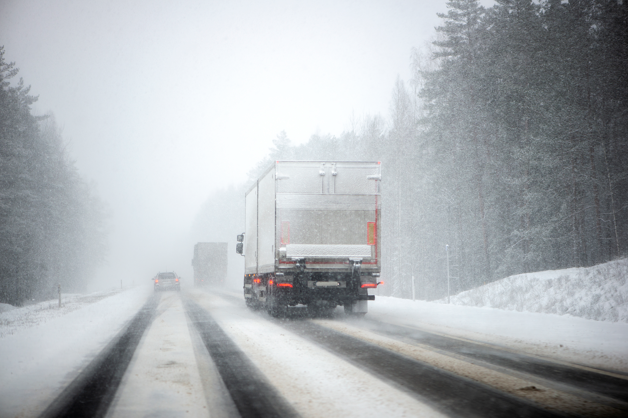Winter driving presents unique challenges for all motorists, but truckers face an even higher level of risk due to the size and weight of their vehicles. Inclement weather, slippery roads, and maintenance issues can make winter driving treacherous. To mitigate these risks and ensure safety on the road, flatbed truckers should be well-prepared and informed.
By adopting safe driving practices, staying informed about weather conditions, and ensuring their vehicles are properly maintained, truckers can increase their chances of a safe and successful winter driving season.
Essential Equipment for Winter Flatbed Trucking
Winter driving can be unpredictable and challenging, especially for truckers. To prepare for potential emergencies and ensure safety on the road, it’s essential to have a well-stocked toolbox with essential equipment. Some options to keep on hand are:
- Warm Clothing: Hats, rubber-tipped gloves, and a warm jacket are crucial for staying comfortable and safe in cold weather.
- Emergency Tools: A flashlight, a first aid kit, jumper cables, and a tire repair kit are essential for handling unexpected situations.
- Tarping Supplies: A variety of tarps, bungee cords, and ropes are necessary for securing and protecting cargo in inclement weather. Pro Tip: Warm tarps are easier to use and less likely to tear than ones left in the cold. Bring your tarps into the cab before using.
- Work Lights: Adequate lighting is essential for working on your truck in low-light conditions.
- Trailer Stabilizer Dolly: This can help prevent accidents on slippery surfaces.
- Air Brake Tubing: Cold temperatures can affect air brake hoses, so having spare tubing is essential.
- Beacon Lights: These can increase your visibility and prevent accidents.
By carrying these essential items, flatbed truckers can be better prepared to handle winter challenges and ensure their safety on the road.
Vehicle Safety and Maintenace
Regular maintenance is essential for safe winter driving. Ensure your battery is in good condition, make sure your brakes are working properly, and inspect and replace fluids as needed. It’s also crucial to inspect and maintain your tires. Check your tire tread depth to ensure adequate traction on slippery roads. Cold weather can cause tire pressure to drop, so regularly check and adjust pressure to the recommended level. By taking these precautions, you can help prevent accidents and enhance your safety during the winter months.
Winter Driving Safety
To ensure safe winter driving, it’s essential to prepare your vehicle for the elements. Below are some suggestions.
Vehicle Preparation
- Clean off all snow and frost from:
-
- Windshield
-
- Side windows
-
- Mirrors
-
- Lights
- Winterize your vehicle.
-
- Check and replace wiper blades if necessary.
-
- Ensure adequate antifreeze/coolant levels.
-
- Inspect and replace worn tires with winter tires or all-season tires with good tread depth.
-
- Test battery and charging system.
-
- Pack an emergency kit with essentials like blankets, water, snacks, a flashlight, jumper cables, and a first-aid kit.
Safe Driving Practices
- Adjust your driving style.
-
- Reduce speed, especially on slippery roads.
-
- Increase your following distance to at least five seconds.
-
- Avoid sudden braking and acceleration.
-
- Use low gear to maintain control on hills.
-
- Avoid using cruise control on slippery surfaces.
- Be aware of road conditions:
-
- Watch for black ice, especially on bridges, overpasses, and shaded areas.
-
- Be cautious of slush and standing water, as they can hide icy patches.
-
- Drive slowly and carefully in fog, snow, and heavy rain.
- Stay informed:
-
- Check weather forecasts and road conditions before driving.
-
- Consider postponing non-essential trips during severe weather.
Emergency Preparedness
- If you get stuck:
-
- Stay with your vehicle.
-
- Use your hazard lights to warn other drivers.
-
- Conserve fuel by running the engine periodically for short intervals.
-
- Shovel snow away from exhaust pipe to prevent carbon monoxide poisoning.
- If you’re involved in an accident:
-
- Move your vehicle to a safe location, if possible.
-
- Turn on hazard lights and call for help.
-
- Stay in your vehicle until help arrives.
Most importantly, have a plan for what to do in case of a breakdown. This includes knowing where to seek assistance and making plans for overnight stops. Communicate your travel plans with others and be prepared to spend more time on the road due to winter conditions.
Winter Driving and Hurricane Recovery
As of October 2024, the impact of hurricanes on East Tennessee and Western North Carolina is still being assessed. While most major roads are open, some areas may still experience closures or restrictions due to ongoing recovery efforts. It’s essential to check for the most up-to-date information on road conditions and closures before traveling in these regions. Visit the official websites of the Tennessee Department of Transportation (TDOT) and the North Carolina Department of Transportation (NCDOT) for real-time updates on road conditions and closures.
Safe and Rewarding Trucking Careers at Roane Transportation
Trucking can be a rewarding career, but it requires a commitment to safety. By following best practices and staying informed, you can minimize risks and enjoy a successful career.
Join Roane Transportation, a leading transportation company in East Tennessee. We’re currently hiring drivers in multiple locations, offering competitive pay, and excellent benefits. Our state-of-the-art equipment ensures the safety of our drivers and the loads they carry. Contact us today at 865-354-3288 to learn more or visit us online to start your career!

